Deck 49: An Introduction to Ecology
Question
Question
Question
Question
Question
Question
Question
Question
Question
Question
Question
Question
Question
Question
Question
Question
Question
Question
Question
Question
Question
Question
Question
Question
Question
Question
Question
Question
Question
Question
Question
Question
Question
Question
Question
Question
Question
Question
Question
Question

Unlock Deck
Sign up to unlock the cards in this deck!
Unlock Deck
Unlock Deck
1/40
Play
Full screen (f)
Deck 49: An Introduction to Ecology
1
What would happen to the seasons if the Earth were tilted 35 degrees off its orbital plane instead of the usual 23.5 degrees?
A) The seasons would disappear.
B) Winters and summers would be more severe.
C) Winters and summers would be less severe.
D) The seasons would be shorter.
A) The seasons would disappear.
B) Winters and summers would be more severe.
C) Winters and summers would be less severe.
D) The seasons would be shorter.
B
2
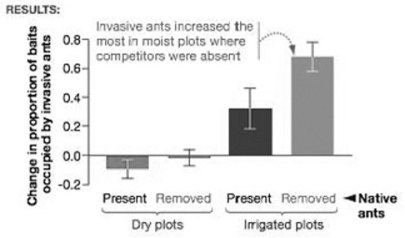 The accompanying graph shows data from a research study designed to test the hypothesis that both abiotic and biotic factors can affect the distribution of invasive Argentine ants. Using the graph, identify the statement that is best supported by the data.
The accompanying graph shows data from a research study designed to test the hypothesis that both abiotic and biotic factors can affect the distribution of invasive Argentine ants. Using the graph, identify the statement that is best supported by the data.A) Abiotic factors (e.g., soil moisture) only affect the distribution of invasive Argentine ants.
B) Biotic factors (e.g., competition) only affect the distribution of invasive Argentine ants.
C) Both abiotic and biotic factors interact to affect the distribution of invasive Argentine ants.
D) Neither abiotic nor biotic factors affect the distribution of invasive Argentine ants.
C
3
If the Earth were to reorient such that the North Pole always received direct sunlight (always faced the Sun), how would that change Earth's climate?
A) The equators would not change in climate.
B) The South Pole would get colder.
C) The equators would get warmer.
D) The North Pole would get more wind.
A) The equators would not change in climate.
B) The South Pole would get colder.
C) The equators would get warmer.
D) The North Pole would get more wind.
B
4
Which abiotic factor would have the most significant acute physiological effect on migrating salmon as they move from saltwater to freshwater?
A) salinity differences
B) competition for resources
C) ambient temperature
D) human-built structural interferences
A) salinity differences
B) competition for resources
C) ambient temperature
D) human-built structural interferences

Unlock Deck
Unlock for access to all 40 flashcards in this deck.
Unlock Deck
k this deck
5
Which of the following are important biotic factors that can affect the structure and organization of biological communities?
A) precipitation, wind
B) nutrient availability, soil pH
C) predation, competition
D) temperature, water
E) light intensity, seasonality
A) precipitation, wind
B) nutrient availability, soil pH
C) predation, competition
D) temperature, water
E) light intensity, seasonality

Unlock Deck
Unlock for access to all 40 flashcards in this deck.
Unlock Deck
k this deck
6
As climate changes because of global warming, plant species' ranges in the northern hemisphere may move northward. The trees that are most likely to avoid extinction in such an environment are those that ________.
A) have seeds that are easily dispersed by wind or animals
B) have thin seed coats
C) produce well-provisioned seeds
D) have seeds that become viable only after a forest fire
E) disperse many seeds in close proximity to the parent tree
A) have seeds that are easily dispersed by wind or animals
B) have thin seed coats
C) produce well-provisioned seeds
D) have seeds that become viable only after a forest fire
E) disperse many seeds in close proximity to the parent tree

Unlock Deck
Unlock for access to all 40 flashcards in this deck.
Unlock Deck
k this deck
7
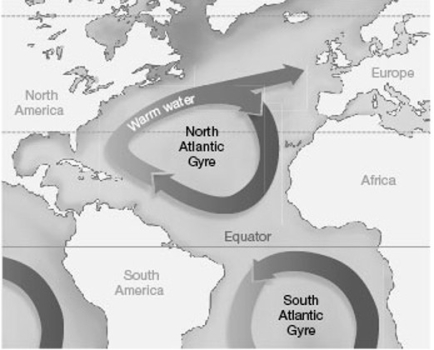 In the map above, which region would have milder weather than expected without the ocean currents?
In the map above, which region would have milder weather than expected without the ocean currents?A) Africa
B) North America
C) Antarctica
D) Europe
E) Newfoundland

Unlock Deck
Unlock for access to all 40 flashcards in this deck.
Unlock Deck
k this deck
8
A certain species of pine tree survives only in scattered locations at elevations above 2800 meters in the western United States. To understand why this tree grows only in these specific places, an ecologist should ________.
A) conclude that lower elevations are limiting to the survival of this species
B) study the anatomy and physiology of this species
C) investigate the various biotic and abiotic factors that are unique to high altitude
D) analyze the soils found in the vicinity of these trees, looking for unique chemicals that may support their growth
E) collect data on temperature, wind, and precipitation at several of these locations for a year
A) conclude that lower elevations are limiting to the survival of this species
B) study the anatomy and physiology of this species
C) investigate the various biotic and abiotic factors that are unique to high altitude
D) analyze the soils found in the vicinity of these trees, looking for unique chemicals that may support their growth
E) collect data on temperature, wind, and precipitation at several of these locations for a year

Unlock Deck
Unlock for access to all 40 flashcards in this deck.
Unlock Deck
k this deck
9
How does solar radiation (per unit area) vary with latitude?
A) It increases.
B) It decreases.
C) It does not change.
D) It oscillates between higher and lower.
A) It increases.
B) It decreases.
C) It does not change.
D) It oscillates between higher and lower.

Unlock Deck
Unlock for access to all 40 flashcards in this deck.
Unlock Deck
k this deck
10
The main reason polar regions are cooler than the equator is that ________.
A) there is more ice at the poles
B) sunlight strikes the poles at a lower angle
C) the poles are farther from the Sun
D) the polar atmosphere is thinner and contains fewer greenhouse gases
E) the poles are permanently tilted away from the Sun
A) there is more ice at the poles
B) sunlight strikes the poles at a lower angle
C) the poles are farther from the Sun
D) the polar atmosphere is thinner and contains fewer greenhouse gases
E) the poles are permanently tilted away from the Sun

Unlock Deck
Unlock for access to all 40 flashcards in this deck.
Unlock Deck
k this deck
11
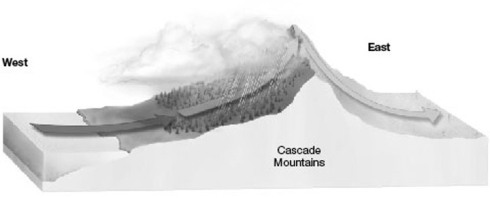
In the figure above, which direction will have a desert biome?
A) South
B) East
C) West
D) North
E) Both West and East

Unlock Deck
Unlock for access to all 40 flashcards in this deck.
Unlock Deck
k this deck
12
For a species to be called "invasive," it must ________.
I) be introduced to a new area
II) spread rapidly in this new area
III) compete with native species successfully
A) only I
B) only II
C) only III
D) only II and III
E) I, II, and III
I) be introduced to a new area
II) spread rapidly in this new area
III) compete with native species successfully
A) only I
B) only II
C) only III
D) only II and III
E) I, II, and III

Unlock Deck
Unlock for access to all 40 flashcards in this deck.
Unlock Deck
k this deck
13
Theoretically, which would be the most effective way to disrupt a Hadley cell?
A) Remove all equatorial moisture and convection.
B) Extensively water the deserts.
C) Heat the poles.
D) Shift the Sun to apply direct rays 30 degrees south latitude.
A) Remove all equatorial moisture and convection.
B) Extensively water the deserts.
C) Heat the poles.
D) Shift the Sun to apply direct rays 30 degrees south latitude.

Unlock Deck
Unlock for access to all 40 flashcards in this deck.
Unlock Deck
k this deck
14

In the figure above, which direction will have a rain shadow?
A) South
B) East
C) West
D) North
E) Both West and East

Unlock Deck
Unlock for access to all 40 flashcards in this deck.
Unlock Deck
k this deck
15
Which of the following levels of ecological organization is arranged in the correct sequence from most to least inclusive?
A) community, ecosystem, organism, population
B) ecosystem, community, population, organism
C) population, ecosystem, organism, community
D) organism, population, community, ecosystem
E) organism, community, population, ecosystem
A) community, ecosystem, organism, population
B) ecosystem, community, population, organism
C) population, ecosystem, organism, community
D) organism, population, community, ecosystem
E) organism, community, population, ecosystem

Unlock Deck
Unlock for access to all 40 flashcards in this deck.
Unlock Deck
k this deck
16
Which is a likely biotic factor limiting songbird distribution in Hawaii to alpine habitats?
A) temperature
B) oxygen content
C) moisture
D) insects causing fatal diseases in songbirds at lower altitudes
A) temperature
B) oxygen content
C) moisture
D) insects causing fatal diseases in songbirds at lower altitudes

Unlock Deck
Unlock for access to all 40 flashcards in this deck.
Unlock Deck
k this deck
17
Which level of ecological study focuses the most on abiotic factors?
A) speciation ecology
B) population ecology
C) community ecology
D) ecosystem ecology
A) speciation ecology
B) population ecology
C) community ecology
D) ecosystem ecology

Unlock Deck
Unlock for access to all 40 flashcards in this deck.
Unlock Deck
k this deck
18

In the map above, where will the weather be wetter?
I) near 30° N
II) near 30° S
III) near the Equator
A) only I and II
B) only II and III
C) only I and III
D) only I
E) only III

Unlock Deck
Unlock for access to all 40 flashcards in this deck.
Unlock Deck
k this deck
19
Which of the following statements regarding altitude and climate are TRUE?
I) Species composition on different sides of a mountain range are often different from each other.
II) Rain shadows may appear on one side of a mountain range.
III) The higher the altitude, the warmer the climate.
IV) Both sides of a mountain range generally receive equal amounts of precipitation.
A) only I and II
B) only III and IV
C) only I, II, and IV
D) only II, III, and IV
E) only I, II, and III
I) Species composition on different sides of a mountain range are often different from each other.
II) Rain shadows may appear on one side of a mountain range.
III) The higher the altitude, the warmer the climate.
IV) Both sides of a mountain range generally receive equal amounts of precipitation.
A) only I and II
B) only III and IV
C) only I, II, and IV
D) only II, III, and IV
E) only I, II, and III

Unlock Deck
Unlock for access to all 40 flashcards in this deck.
Unlock Deck
k this deck
20

In the map above, where will the weather be drier?
I) near 30° N
II) near 30° S
III) near the Equator
A) only I and II
B) only II and III
C) only I and III
D) only I
E) only III

Unlock Deck
Unlock for access to all 40 flashcards in this deck.
Unlock Deck
k this deck
21
Imagine that a deep temperate-zone lake did not turn over during the spring and fall seasons. Based on the physical and biological properties of limnetic ecosystems, what would be the difference from normal seasonal turnover?
A) The lake would be uniformly cold during the winter and summer.
B) The lake would fail to freeze over in winter.
C) An algal bloom of algae would result every spring.
D) Lakes would suffer a nutrient depletion in surface layers.
E) The pH of the lake would become increasingly alkaline.
A) The lake would be uniformly cold during the winter and summer.
B) The lake would fail to freeze over in winter.
C) An algal bloom of algae would result every spring.
D) Lakes would suffer a nutrient depletion in surface layers.
E) The pH of the lake would become increasingly alkaline.

Unlock Deck
Unlock for access to all 40 flashcards in this deck.
Unlock Deck
k this deck
22
The diagram shows a generalized cross section of the marine environment with various zones labeled with letters. 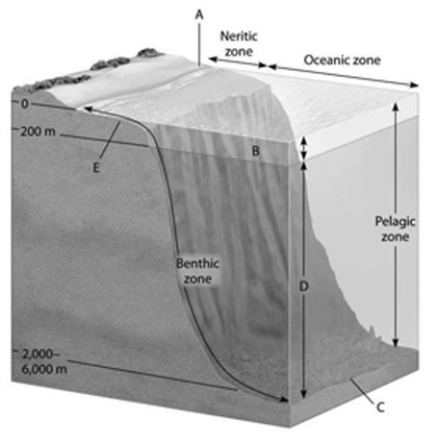
Which zone produces the most global oxygen gas?
A) A
B) B
C) C
D) D
E) E

Which zone produces the most global oxygen gas?
A) A
B) B
C) C
D) D
E) E

Unlock Deck
Unlock for access to all 40 flashcards in this deck.
Unlock Deck
k this deck
23
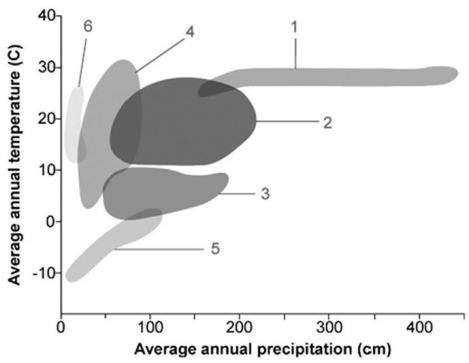
In the accompanying figure, which number would designate the arctic tundra biome?
A) 2
B) 3
C) 4
D) 5
E) The arctic tundra is not designated by a number in the figure.

Unlock Deck
Unlock for access to all 40 flashcards in this deck.
Unlock Deck
k this deck
24
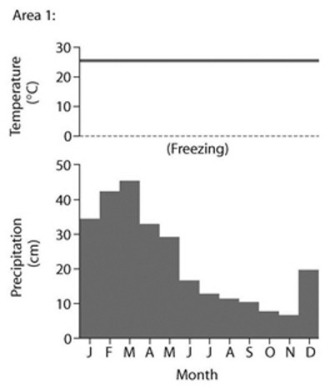
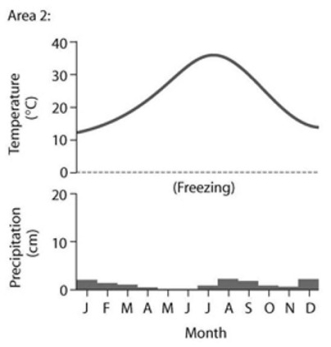
Based on the data in the figure, which of the following statements is TRUE?
A) Area 1 could be called a boreal forest/taiga.
B) Area 2 could be called a temperate grassland.
C) Area 1 could be called a tropical wet/rain forest.
D) Area 2 could be tundra.

Unlock Deck
Unlock for access to all 40 flashcards in this deck.
Unlock Deck
k this deck
25
Turnover of water in temperate lakes during the spring and fall is made possible by which of the following?
A) warm, less-dense water layered at the top
B) cold, more-dense water layered at the bottom
C) a distinct thermocline between less-dense, warm water and cold, dense water
D) the changes in the density of water as seasonal temperatures change
E) currents generated by nektonic animals
A) warm, less-dense water layered at the top
B) cold, more-dense water layered at the bottom
C) a distinct thermocline between less-dense, warm water and cold, dense water
D) the changes in the density of water as seasonal temperatures change
E) currents generated by nektonic animals

Unlock Deck
Unlock for access to all 40 flashcards in this deck.
Unlock Deck
k this deck
26
The diagram shows a generalized cross section of the marine environment with various zones labeled with letters. 
Which zone has a condition of constant temperature?
A) A
B) B
C) C
D) D
E) E

Which zone has a condition of constant temperature?
A) A
B) B
C) C
D) D
E) E

Unlock Deck
Unlock for access to all 40 flashcards in this deck.
Unlock Deck
k this deck
27
The diagram shows a generalized cross section of the marine environment with various zones labeled with letters. 
Which zone experiences the most abiotic change over a 24-hour period?
A) A
B) B
C) C
D) D
E) E

Which zone experiences the most abiotic change over a 24-hour period?
A) A
B) B
C) C
D) D
E) E

Unlock Deck
Unlock for access to all 40 flashcards in this deck.
Unlock Deck
k this deck
28
If you are interested in observing a relatively simple community structure in a clear-water lake, you would do well to choose diving into ________.
A) an oligotrophic lake
B) a eutrophic lake
C) a relatively shallow lake
D) a nutrient-rich lake
E) a lake with consistently warm temperatures
A) an oligotrophic lake
B) a eutrophic lake
C) a relatively shallow lake
D) a nutrient-rich lake
E) a lake with consistently warm temperatures

Unlock Deck
Unlock for access to all 40 flashcards in this deck.
Unlock Deck
k this deck
29
If a meteor impact or volcanic eruption injected a lot of dust into the atmosphere and reduced the sunlight reaching Earth's surface by 70 percent for 1 year, which of the following marine communities most likely would be LEAST affected?
A) deep-sea vent
B) coral reef
C) intertidal
D) pelagic
E) estuary
A) deep-sea vent
B) coral reef
C) intertidal
D) pelagic
E) estuary

Unlock Deck
Unlock for access to all 40 flashcards in this deck.
Unlock Deck
k this deck
30
Which of the following can be said about light in aquatic environments?
A) Water selectively reflects and absorbs certain wavelengths of light.
B) Photosynthetic organisms that live in deep water probably use red light.
C) Longer wavelengths penetrate to greater depths.
D) Light penetration seldom limits the distribution of photosynthetic species.
E) Most photosynthetic organisms avoid the surface where the light is too intense.
A) Water selectively reflects and absorbs certain wavelengths of light.
B) Photosynthetic organisms that live in deep water probably use red light.
C) Longer wavelengths penetrate to greater depths.
D) Light penetration seldom limits the distribution of photosynthetic species.
E) Most photosynthetic organisms avoid the surface where the light is too intense.

Unlock Deck
Unlock for access to all 40 flashcards in this deck.
Unlock Deck
k this deck
31

In the figure, which number would designate the biome with the highest variation in annual precipitation?
A) 1
B) 2
C) 3
D) 4

Unlock Deck
Unlock for access to all 40 flashcards in this deck.
Unlock Deck
k this deck
32
Which of the following is responsible for the differences in summer and winter temperature stratification of deep temperate-zone lakes?
A) Water is densest at 4°C.
B) Oxygen is most abundant in deeper waters.
C) Winter ice sinks in the summer.
D) Stratification is caused by a thermocline.
E) Stratification always follows the fall and spring turnovers.
A) Water is densest at 4°C.
B) Oxygen is most abundant in deeper waters.
C) Winter ice sinks in the summer.
D) Stratification is caused by a thermocline.
E) Stratification always follows the fall and spring turnovers.

Unlock Deck
Unlock for access to all 40 flashcards in this deck.
Unlock Deck
k this deck
33
The specific abiotic factors defining a biome are ________.
I) annual variation in temperature and precipitation
II) average annual temperature and moisture levels
III) maximum annual temperature and moisture levels
IV) maximum annual temperatures, moisture levels, and average annual temperature
A) only I and II
B) only III and IV
C) only I, II, and IV
D) only II, III, and IV
E) only I, II, and III
I) annual variation in temperature and precipitation
II) average annual temperature and moisture levels
III) maximum annual temperature and moisture levels
IV) maximum annual temperatures, moisture levels, and average annual temperature
A) only I and II
B) only III and IV
C) only I, II, and IV
D) only II, III, and IV
E) only I, II, and III

Unlock Deck
Unlock for access to all 40 flashcards in this deck.
Unlock Deck
k this deck
34
Which of the following statements best describes the effect of climate on biome distribution?
A) Average annual temperature and precipitation are sufficient to predict which biome will be found in an area.
B) Seasonal fluctuation of temperature is not a limiting factor in biome distribution if areas have the same annual temperature and precipitation means.
C) The average climate and pattern of climate are important in determining biome distribution.
D) Temperate forests and grasslands are different biomes because they receive a different quality and quantity of sunlight, even though they have essentially the same annual temperature and precipitation.
E) Correlation of climate with biome distribution is sufficient to determine the cause of biome patterns.
A) Average annual temperature and precipitation are sufficient to predict which biome will be found in an area.
B) Seasonal fluctuation of temperature is not a limiting factor in biome distribution if areas have the same annual temperature and precipitation means.
C) The average climate and pattern of climate are important in determining biome distribution.
D) Temperate forests and grasslands are different biomes because they receive a different quality and quantity of sunlight, even though they have essentially the same annual temperature and precipitation.
E) Correlation of climate with biome distribution is sufficient to determine the cause of biome patterns.

Unlock Deck
Unlock for access to all 40 flashcards in this deck.
Unlock Deck
k this deck
35


Based on the data in the accompanying figure, which of the following statements are correct?
I) Area 1 would be considered a desert because of its high average temperature.
II) Area 1 has more average precipitation than Area 2.
III) Area 2 would be considered a desert because of its low average precipitation.
IV) Area 2 has a larger annual temperature variation.
A) only I and III
B) only II and IV
C) only I, II, and IV
D) only II, III, and IV
E) only I, II, and III

Unlock Deck
Unlock for access to all 40 flashcards in this deck.
Unlock Deck
k this deck
36
In temperate lakes, the surface water is replenished with nutrients during turnovers that occur in the ________.
A) autumn and spring
B) autumn and winter
C) spring and summer
D) summer and winter
E) summer and autumn
A) autumn and spring
B) autumn and winter
C) spring and summer
D) summer and winter
E) summer and autumn

Unlock Deck
Unlock for access to all 40 flashcards in this deck.
Unlock Deck
k this deck
37

Which of the following biomes has the highest variation in annual temperature?
A) subtropical deserts
B) arctic tundra
C) temperate forests
D) temperate grasslands
E) boreal forests/taiga

Unlock Deck
Unlock for access to all 40 flashcards in this deck.
Unlock Deck
k this deck
38
Which marine zone would have the lowest rates of primary productivity (photosynthesis)?
A) pelagic
B) aphotic
C) neritic
D) continental shelf
E) intertidal
A) pelagic
B) aphotic
C) neritic
D) continental shelf
E) intertidal

Unlock Deck
Unlock for access to all 40 flashcards in this deck.
Unlock Deck
k this deck
39

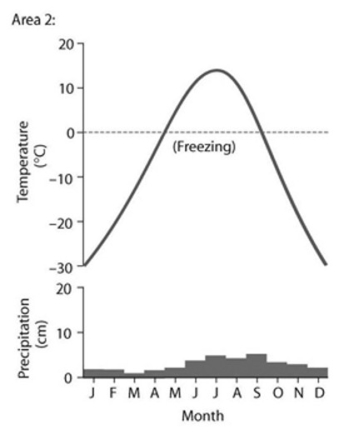
Based on the data in the figure, which of the following statements is TRUE?
A) The data from Area 1 describes a subtropical desert.
B) The data from Area 2 describes an arctic tundra.
C) The data from Area 1 describes a tropical wet/rain forest.
D) The data from Area 2 describes a boreal forest.

Unlock Deck
Unlock for access to all 40 flashcards in this deck.
Unlock Deck
k this deck
40


Based on the data in the accompanying figure, which of the following statements are correct?
I) Area 1 has more average precipitation than Area 2.
II) Area 1 has a higher average temperature than Area 2.
III) Both areas have low variation in monthly precipitation.
IV) Area 2 has a lower annual temperature variation compared to Area 1.
A) only I and III
B) only II and IV
C) only I, II, and IV
D) only II, III, and IV
E) only I, II, and III

Unlock Deck
Unlock for access to all 40 flashcards in this deck.
Unlock Deck
k this deck



